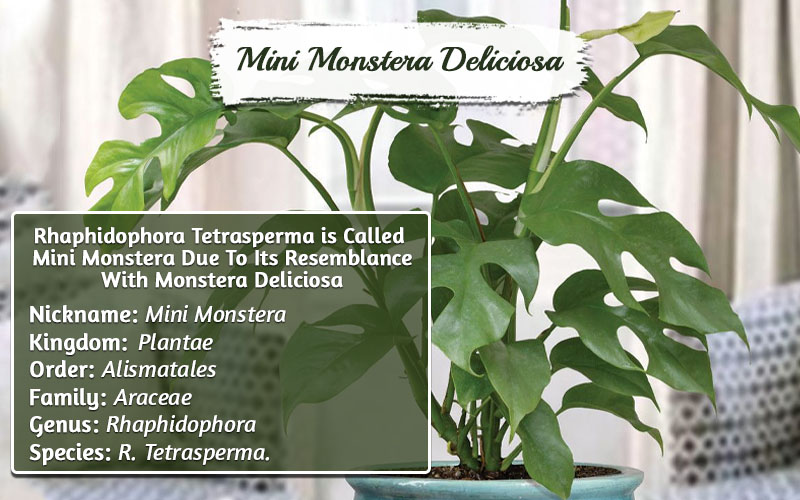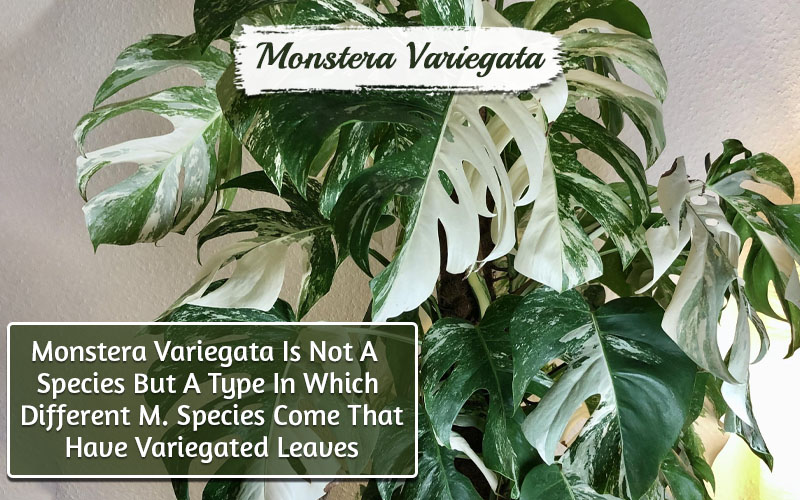Monstera is a genus that provides elegant houseplants.
It has more than 48 different species, and from them, only some can be found commonly; you can grow at homes.
Types of monstera plants are known for their leaves fenestration (holes occur naturally when foliage gets mature).
Monsteras are nicknamed “Swiss Cheese Plants” as they have holes inside the leaves, just like swiss cheese.
| Genus | Monstera |
| Nickname | Swiss Cheese Plant |
| Family | Araceae / Arum |
| Known species | 48 |
| Plant Type | House plant |
| Plant Temperament | Tropical / Trailing / Vines |
| Plant Growth | Evergreen vines |
| Native | Central America (usually) |
| Fruit | Yes, in some species |
| Flowers | Spadix |
Table of Contents
Monstera Leaf:
These plants have very different growth profiles, especially when it comes to monstera leaves. When the plant is juvenile, the leaves do not show any fenestration or holes.
However, once the plants start to mature, the monstera leaf also starts getting bigger and bigger. In these giant leaves, holes pop up out of nowhere.
These holes keep getting broader, and in some varieties, they break the leaf edges and divide one leaf into separate parts.
This hole popping is known as Leaf fenestration in botanical terms. This is the very reason that makes monsteras a Swiss Cheese Plant.
On the other hand, some leaves come without fenestration; still, they are decorative and pretty, such as the leaves of monstera dubia and Monstera pinnatipartite.
Monstera Fruit:
In all monstera varieties, you find a berry-like fruit that grows on the spadix of the plant.
As the research is yet going, many people have different experiences with monstera fruit.

For example, some of its species produce edible and non-toxic fruits, while some have mildly toxic traits and are harmful to animals and humans.
Varieties such as Monstera deliciosa produce edible fruit with a salad-like taste, known as a salad fruit tree or fruit salad plant.
It is also found that monstera adansonii produces perfect coffee beans and hence produces edible fruits.
However, you are not recommended to eat seeds or fruits of monster epipremnoides as the plant is toxic to humans. Keep animals away from this plant too.
Let’s discuss all in details:
Types of Monstera query actually refers to species of monstera genus or varieties of monstera.
Here you will find a complete guide of different monstera varieties you find in nurseries near you to grow at homes.

PS: the blog also contains the key that will help you buy the original monstera you are looking for so that you don’t get conned when buying different types of monstera plants.
Monstera Varieties You Can Grow At Homes:
From 48 found species of Monstera plants, we will be discussing the top 10 monstera varieties that you can easily grow and care for at home.
1. Monstera Obliqua:

Obliqua is a rare species of monstera genus but very much in demand, and plant enthusiasts keep looking for it in the nurseries.
It is found in abundance on the amazon basin and places like Panama, southern America, Costa Rica, Peru, Guianas, etc.
Obliqua is strange; you find some of its varieties with beautiful fenestration while some with no fenestration at all.
Monstera Peru is the most sought-after type of monstera plant as it has more holes than leaves, while the Bolivian type has no holes at all.
Obliqua is an easy-to-take care plant with no challenging behavior. However, the real challenge is finding the original obliqua.
Click to find a complete guide on monstera obliqua growth and care.
2. Monstera Adansonii:

Adansonii another beautifully fenestrated plant from the genus monstera, native to Brazil, Ecuador, Peru, South America, and Central America.
This swiss cheese plant is often sold in markets as monstera obliqua, as the latter is a rare but demanding houseplant for plant lovers.
Monstera Adansonii [adan-so-knee-eye is also known as Monstera Friedrichsthalii [Mon-STER-uh, Free-dreech-sta-lia-na] or Swiss Cheese Vine.
This house plant is not any different than its siblings; little water, some shady area, and a lot of humidity will get it thriving.
Click and learn all about monstera adansonii care.
3. Monstera Epipremnoides:
Monstera Epipremnoides is an aroid and effortlessly growable tropical plant from the genus monstera that requires little care indoors or out.

It is sometimes referred to as XL monstera epipremnoides because it grows to a large size as big as a giant. It has fenestrated leaves like the rest of the monstera plants.
Planting it in homes is extremely easy and effortless.
To know all about Monstera epipremnoides care, click the link.
4. Monstera Deliciosa:
Another swiss cheese plant, the monster deliciosa, is the “Most-Demanding” variety of monsteras that grows widely in tropical forests of southern Mexico, south to Panama.

M deliciosa is different from M.obliqua based on its leaves. Although both types have fenestration in leaves, still the difference is, obliqua has holes while the other one, deliciosa, has split leaves.
The different thing about monstera deliciosa is its root system that’s not just underground but also outer ground; the roots start to pop out of stems.
They are easy to grow, care for, and maintain and be an excellent addition to your homes.
5. Mini Monstera Delisiosa:
Mini monstera isn’t actually a monstera, in fact, the real name of the plant is Rhaphidophora tetrasperma. It belongs to an entirely different genus.

It is also an aroid; however, the genus is Rhaphidophora. It is called a mini monstera because the plant leaves are exactly resembling Monstera Deliciosa.
You can call it an indoor version of the giant tree monstera deliciosa.
Learn more about this Mini monstera Rhaphidohphora tetrasperma by clicking the link.
6. Monstera Siltepecana:
Monstera siltepecana is the rarest and hard to find species of the swiss cheese plant genus.

Monstera siltepecana doesn’t have holes in the leaves but is known for the glossy silvery hue inside the leaves, more towards the mid-vein than the edges.
Also, unlike other monstera varieties, the leaves of Monstera Siltepecana are smaller, silver, and glossy with a lance shape.
It is a rare, evergreen aroid that grows like a climber vine.
If you come to find this rare unicorn aroid, it will prove as the most low maintenance plant that dwells so well, indoor and outdoor, in all areas, with just a provided support.
7. Monstera dubia:
Monstera dubia has smaller leaves. It is a less common species of the genus monstera; however, it can be an excellent addition to your homes, thanks to its low maintenance quality.

Monstera dubia doesn’t have leaves with holes but has decorative foliage like its sister, Monstera siltepecana, having dark and bright greens stripes inside.
They grow like climbers from the seed stage to the forest floor and are native to Central and South America.
This easy maintenance monstera variety can be an excellent thing to add to your home.
8. Monstera standleyana:
Monstera standleyana is different from its sibling monstera member plants, as it is comparatively a slow grower. However, it doesn’t mean that it is challenging to develop and care for plants.

Monstera standleyana can be grown from indoor to outdoor in all types of places for its lush green appearance and decorative foliage.
One thing you will have to consider is the temperature when growing and Monstera standleyana care. They love mild temperatures while they can show tantrums when conditions go severe.
Rest of the monstera Monstera standleyana care is easy.
9. Monstera Pinnatipartita:
Monstera Pinnatipartita or the five holes plant is another lovely species from the aroid family.

Though most of the monsteras can be differentiated only with mature leaves, you can identify Pinnatipartita easily, even when the leaves are juvenile.
How? by their combination of perforations and variegated leaves. Yes, you get leaves with bleached edges or a bright spray of a light green hue.
The enchanting climber will dwell so well in the balconies or near your tree trunks.
When it comes to Monstera Pinnatipartita care, it is not so hard.
All you need to do is find a well-draining and breathable soil, as, like all other plants, the excessive water in the bottom can cause root rot.
10. Monstera Variegata
Monstera Variegata is not a single species of monstera genus but a type of variety in which various types of monstera plants come.

All the monsteras with variegated leaves appear in this variety. Most of the time, due to the lack of chlorophyll in the monstera leaves, they start to lack their original lush green color.
Sometimes the condition doesn’t bring any harm to the overall health of your monstera plants; however, in rare situations, this loss of color can happen due to fungal infection in your plant.
In this case, you will have to immediately take action against the insects or germs causing fungus in the leaves of your plant.
Varieties of Monstera Care:
Taking care of your monstera plant is not as challenging as it might seem; the genus monstera offers the most effortlessly care for plants.

Remember, monstera care varies for each plant; here, we are discussing only some general points.
· Placement:
Monsteras grow so big; hence, when placing your plant, find a vast space. Indoors can grow up to 3 meters tall and outdoor even more than that; 20 meters.
· Watering:
Monstera plants aren’t like the Selaginella genus, where different varieties have different requirements for watering. In this, all types require moderate once-a-week watering.
· Humidity:
As climbers and houseplants, all Monsteras are in love with humidity. Humidity helps them to grow, stay happier, and keep insects away from them.
· Soil:
Monstera plants love well-drained potting mix soil. They hate sagginess, and their roots can rot in such cases. However, dampness in the ground should stay constant.
· Fertilizers:
Monstera plants are very independent and hate over-fertilizing. You will offer nutrients to your plant only in the growing season. Make sure to use only organic and well-nourished fertilizers.
Bottom Line:
If you are interested in rare yet easy to grow plants at homes, our blog is dwelling with such stuff. You will get authentic information on plants as well as animals. Bookmark it so that you don’t miss any posts.
If you like our work, please leave a comment and share our guides with your friends.

